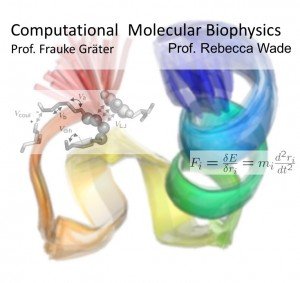2018: Lectures and Hands-on sessions in computational molecular biophysics

Computational Molecular Biophysics
How can a bird sense magnetic fields, how does our ear detect sound waves, how does our bone feel gravitation? It is the physics of individual molecules that dictate these and many other processes in life.
This course introduces computational methods to study the structure, dynamics and mechanics of biomolecules at different scales. It aims at endowing the students with an active understanding of the principles, the capacity and limitations of different molecular simulation techniques, including Monte Carlo, Molecular Dynamics, Brownian Dynamics and multi-scale simulations with an emphasis on Molecular Dynamics simulations. The course comprises alternating lectures and hands-on computer tutorials of which the latter are meant to directly demonstrate the principles of running and analyzing computer simulations of biological matter.
Lectures will be given by Prof. Frauke Gräter and Prof. Rebecca Wade. The lectures will be targeted to advanced Bachelor, Master and interested PhD students and will be complemented by hands-on computer sessions in which the students will have the opportunity to run molecular simulations supervised by Ms. Fabian Kutzki, Dr. Fan Jin, Dr. Kashif Sadiq and Dr. Prajwal Nandekar.
Time and place:
Lectures and hands-on computer tutorials will take place in room number 3.103 in Mathematikon. The lectures/tutorials will take place once a week, on Tuesdays, 14-15.30 pm (2 SWS).
Schedule
| Date | L/P | Topic | Lecturer | |
| 16.10. | L | Introduction into Mechanobiology, MD | FG | |
| 23.10. | L | Monte Carlo, MD and force fields | FG | |
| 30.10. | P | MD: argon | FG | |
| 6.11. | P | MD: ubiquitin | FG | |
| 13.11. | L | MD and force probe MD | FG | |
| 20.11. | P | MD: ubiquitin | FG | |
| 27.11. | L | Calculating free energies in MD | FG | |
| 4.12. | P | force-probe MD: ubiquitin | FG | |
| 11.12. | L | Coarse-grained and multi-scale MD | FG | |
| 18.12. | L/P | finite element analysis DNA | FG | assignment |
| 8.1. | L | Continuum electrostatics | RW | |
| 15.1. | P | Continuum electrostatics | RW | |
| 22.1. | L | BD | RW | |
| 29.1. | P | BD | RW | |
| 5.2. | Question & Answers | FG |
L – lecture, P – practical, FG – Frauke Gräter, RW – Rebecca Wade
Resources:
- Schlick, “Molecular Modelling and Simulation”, Springer, 2010
- M.P. Allen and Tildesley, „Computer Simulation of Liquids“, Oxford Science Publishers. (Great book with a focus on Molecular Dynamics simulations)
- Frenkel und B. Smit. “Understanding molecular simulation” Academic, San Diego, 2002, (covers MD, MC and Stat Mech)
- Dill and S. Bromberg, “Molecular Driving Forces”, Taylor & Francis Inc, 2010
www.gromacs.org open source molecular simulation software used in the tutorial, for both atomistic MD and coarse-grained Brownian dynamics simulations. Comes with an extensive manual, which includes the principles of MD simulations and biomolecular force fields.
http://cando-dna-origami.org/ web-based finite element software for mechanics/dynamics of DNA sculptures
Über das HITS
Das HITS (Heidelberger Institut für Theoretische Studien) wurde 2010 von dem Physiker und SAP-Mitbegründer Klaus Tschira (1940-2015) und der Klaus Tschira Stiftung als privates, gemeinnütziges Forschungsinstitut gegründet. Es betreibt Grundlagenforschung in den Naturwissenschaften, der Mathematik und der Informatik. Zu den Hauptforschungsrichtungen zählen komplexe Simulationen auf verschiedenen Skalen, Datenwissenschaft und -analyse sowie die Entwicklung rechnergestützter Tools für die Forschung. Die Anwendungsfelder reichen von der Molekularbiologie bis zur Astrophysik. Ein wesentliches Merkmal des Instituts ist die Interdisziplinarität, die in zahlreichen gruppen- und disziplinübergreifenden Projekten umgesetzt wird. Die Grundfinanzierung des HITS wird von der Klaus Tschira Stiftung bereitgestellt.